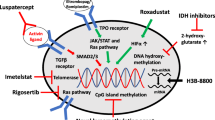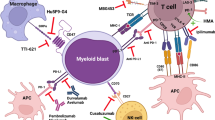Abstract
Over the last several years, there has been substantial progress in the definition, diagnosis, and management of myelodysplastic syndromes (MDSs). This progress includes the new World Health Organization classification and the revised standardized response criteria to be applicable to most new compounds, which, taken together with the International Prognostic Scoring System, provide a uniform basis for the management of individual patients. The recent introduction of certain new agents, as well as an apparent increase in the use of stem cell transplantation with a variety of so-called reduced-intensity settings, has indeed raised the hope that we are entering a new era of MDS treatment.
Similar content being viewed by others
References
Bennett JM, Catovsky D, Daniel MT, et al. Proposal for the classification of the myelodysplastic syndromes.Br J Haematol. 1982;51:189–199.
Larson RA. Myelodysplasia: when to treat and how.Best Pract Res Clin Haematol. 2006;19:293–300.
Steensma DP, Bennett JM. The myelodysplastic syndromes: diagnosis and treatment.Mayo Clin Proc. 2006;81:104–130.
Lindberg EH. Strategies for biology- and molecular-based treatment of myelodysplastic syndromes.Curr Drug Targets. 2005;6:713–725.
Schiffer CA. Clinical issues in the management of patients with myelodysplasia.Hematology Am Soc Hematol Educ Program 2006:205-210.
Hamblin TJ. Epidemiology of the myelodysplastic syndromes. In: Bennett JM, ed.The Myelodysplastic Syndromes: Pathobiology and Clinical Management New York, NY: Marcel Dekker; 2002:15–27.
Aul C, Germing U, Gatterman N, Minning H. Increasing incidence of myelodysplastic syndromes: real or fictitious?Leuk Res. 1998;22:93–100.
Fenaux P. Chromosome and molecular abnormalities in myelodysplastic syndromes.Int J Hematol. 2001;73:429–437.
Corey SJ, Minden MD, Barber DL, Kantarjian H, Wang JC, Schimmer AO. Myelodysplastic syndromes: the complexity of stem-cell diseases.Nat Rev Cancer. 2007;7:118–129.
Vardiman JW, Harris NL, Brunning RD. The World Health Organization (WHO) classification of the myeloid neoplasms.Blood. 2002;100:2292–2302.
Greenberg P, Cox C, LeBeau MM, et al. International scoring system for evaluating prognosis in myelodysplastic syndromes.Blood. 1997;89:2079–2088.
Cheson BD, Greenberg PL, Bennett JM, et al. Clinical application and proposal for modification of the International Working Group (IWG) response criteria in myelodysplasia.Blood. 2006;108:419–425.
Germing U, Gattermann N, Strupp C, Aivado M, Aul C. Validation of the WHO proposals for a new classification of primary myelodysplastic syndromes: a retrospective analysis of 1600 patients.Leuk Res. 2000;24:983–992.
Cazzola M. Alternatives to conventional or myeloablative chemotherapy in myelodysplastic syndrome.Int J Hematol. 2000;72:134–138.
Jädersten M, Montgomery SM, Dybedal I, Porwit-McDonald A, Hellström-Lindberg E. Long-term outcome of treatment of anemia in MDS with erythropoietin and G-CSF.Blood. 2005;106:803–811.
Molldrem JJ, Caples M, Marvoudis D,Plante M, Young NS,Barrett AJ. Antithymocyte globulin for patients with myelodysplastic syndrome.Br J Haematol. 1997;99:699–705.
Joná sova A, Neuwirtová R, Cermák J, et al. Cyclosporin A therapy in hypoplastic MDS patients and certain refractory anaemias without hypoplastic bone marrow.Br J Haematol. 1998;100:304–309.
List A, Dewald G, Bennett J, et al. Lenalidomide in the myelodysplastic syndrome with chromosome 5q deletion.N Engl J Med. 2006;355:1456–1465.
Martino P, Lacobelli S, Brand R, et al. Retrospective comparison of reduced-intensity conditioning and conventional high-dose conditioning for allogeneic hematopoietic stem cell transplantation using HLA-identical sibling donors in myelodysplastic syndromes.Blood. 2006;108:836–846.
de Witte T, van Biezen A, Brand R, et al. Which myelodysplastic syndrome patients are candidates for transplantation?Leuk Res. 2006;30(Suppl 1):S21.
Pellagatti A, Fidler C, Wainscoat JS, Boultwood J. Gene expression profiling in the myelodysplastic syndromes.Hematology. 2005;10:281–287.
Greenberg PL. Myelodysplastic syndromes: iron overload consequences and current chelating therapies. JNatl Compr Canc Netw. 2006;4:91–96.
Author information
Authors and Affiliations
Corresponding author
About this article
Cite this article
Yoshida, Y. Evolving New Treatment for Myelodysplastic Syndromes. Int J Hematol 86, 297–300 (2007). https://doi.org/10.1532/IJH97.07026
Received:
Accepted:
Published:
Issue Date:
DOI: https://doi.org/10.1532/IJH97.07026




